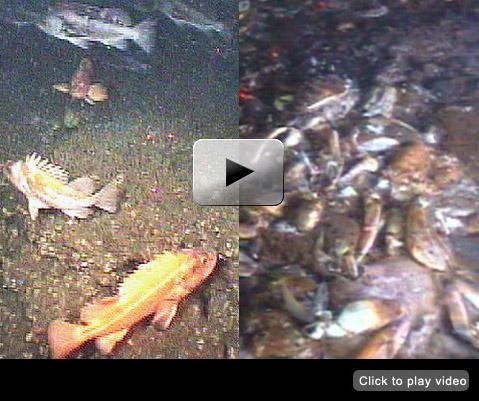
SOS: Is Climate Change Suffocating Our Seas?
16:22 - 02/10/2017
How to Cut the Cost of Wind Energy in Half — A National Lab Report
Kenya brings in world's toughest plastic bag ban: four years jail or $40,000 fine
2 manatees rescued after Irma drains Florida bay
Now you can recycle your batteries in Ha Noi!
Scientists work to explain why massive "dead zones" have been invading the Pacific Northwest's near-shore waters since 2002
Yet another ecological scourge may earn a place on the ever-lengthening list of problems potentially caused by climate change: the formation of some so-called "dead zones"—huge expanses of ocean that lose virtually all of their marine life at depth during the summer.
Possible connections between climate change and the relatively recent formation of dead zones in the Pacific Northwest's coastal waters are currently being studied by a research team that is funded by the National Science Foundation and co-led by Jack Barth of Oregon State University (OSU) and Francis Chan of OSU. (Jane Lubchenco, who is currently on leave from OSU while serving as the Administrator of the National Oceanic and Atmospheric Administration, also previously co-led the team.)
WORLDWIDE DEAD ZONES
The Earth currently has more than 400 oceanic dead zones, with the count doubling every decade. A single dead zone may cover tens of thousands of square miles.
Dead zones form where microscopic plants, known as phytoplankton, are fertilized by excess nutrients, such as fertilizers and sewage, that are generated by human activities and dumped into the ocean by rivers, or more rarely, where they are fertilized by naturally occurring nutrients. The result: blooms of organic matter that ultimately decompose through processes that rob the ocean of life-sustaining oxygen. Animals that fail to flee dead zones either suffocate or suffer severe stress.
LOSING OXYGEN NATURALLY
One of the Earth's relatively few naturally formed dead zones has long been seasonally perched in the deep waters of the continental shelf far from the coast of the Pacific Northwest. This low-oxygen, or "hypoxic," zone has apparently historically remained stationary and is believed to be caused by large-scale processes that are unrelated to human activities or local winds.
But in the summer, northerly summer winds work together with the Earth's rotation to push oxygenated surface water offshore; this coastal water is replaced by low-oxygen but nutrient-rich waters from the depths of the continental shelf in a process known as upwelling. (See illustration.) Once this nutrient-rich water reaches the ocean's sunlit layers, it fertilizes blooms of phytoplankton.
Resulting phytoplankton blooms feed the food chain and thereby help make the Pacific Northwest one of the nation's most productive fisheries. But the decomposition of unconsumed, sunken phytoplankton promotes the formation of deep pools of low-oxygen water.
Periods of upwelling-favorable northerly winds may be interrupted by relatively short periods of southerly winds during the summer and by longer periods during the fall. These southerly winds work together with the Earth's rotation to drive oxygenated surface waters back towards the shore and to drive low-oxygen bottom waters away from the shore in a process known as downwelling. Periods of strong downwelling have traditionally occurred frequently enough to flush the low-oxygen pools from the continental shelf, and thereby prevent them from expanding all the way to the shore.
LEAVING NORMAL
But underwater surveys conducted by the research team of waters off the Pacific Northwest have identified the following new phenomenon:
- Pools of low-oxygen water have expanded from the continental shelf to near-shore waters off Oregon and Washington every summer since 2002; the close proximity of these dead zones to the shore had never been reported before that year.
- Coastal dead zones have been more hypoxic than the low-oxygen pools located on the continental shelf, with some coastal areas periodically completely stripped of their oxygen.
- Areas of hypoxia that have seasonally dotted the Pacific Northwest coast, "have been connected to one another by a ribbon of low-oxygen water that runs along the coastal sea floor," says Barth.
So far, the most hypoxic year for the Pacific Northwest was 2006, when the research team discovered a dead zone off Newport, Oregon that sprawled over almost 1,200 square miles, and pressed so close to the shore that "a baseball hit from Highway 101 during the summer could land in it," says Barth. Covering up to 80 percent of the water column and lasting for an unusually long time (four months), "this dead zone transformed a teeming habitat into a fish-free zone that was carpeted with dead crabs, worms, severely stressed anemones and sea stars, and what looked like potentially noxious bacterial mats," says Barth.
THE SUMMER OF 2009
During the summer of 2009, dead zones characterized by severe hypoxia formed near the seashore on the mid-to-inner shelf in Oregon's coastal waters; they were about average in size and duration. Barth says, "we also saw the now-classic ribbon of low dissolved oxygen water near the seafloor extending along the coast. "However, no zero-oxygen areas like those that formed in 2006 were observed.
ANSWERS MAY BE BLOWING IN THE WIND
Why have low-oxygen waters been regularly expanding into coastal waters? The research team's findings indicate that this phenomenon is potentially related to:
- Reductions in the oxygen content of low-oxygen water that upwells from the continental shelf.
- Prolonged and intensified upwelling along the continental shelf that has, in turn, been caused by periodic increases in the strength of northerly, upwelling-favorable winds and decreases in the frequency of southerly, downwelling-favorable winds.
During periods of prolonged upwelling, each successive wave of upwelling fertilizes more phytoplankton blooms. As these blooms decay, the continental shelf's low-oxygen waters expand, lose more oxygen and move closer to shore.
The more prolonged and intense the downwelling-favorable winds and resulting upwelling are, the more severe the hypoxia becomes. Hence, the highly hypoxic year of 2006 was dominated by particularly strong upwelling-favorable northerly winds, particularly infrequent downwelling-favorable southerly winds and particularly large accumulations of phytoplankton. By contrast, the summer of 2009 was marked by periods of southerly downwelling-favorable winds that helped dissipate low oxygen conditions. "Therefore, the hypoxia of 2009 was neither as extreme nor as long-lasting as that of 2006.
UNDERLYING CAUSES
What is the underlying cause of the decreases in the oxygen content of subsurface offshore waters and changes in coastal winds? One theory points to large-scale cyclic changes in oceanic circulation and atmospheric conditions that have hit the Pacific Northwest every 10 to 20 years. But Barth says evidence that these phenomena are unrelated to one another includes the lack of agreement in the timing of the development of coastal dead zones and the timing of these cyclic changes, which are evidenced in available records covering the last 50 years.
Rather, Barth favors an alternative theory; he suspects that climate change is driving down the oxygen content of subsurface offshore waters and altering coastal winds. This theory is supported by agreement between the predicted effects of climate change and the very types of changes in oceanic and atmospheric conditions and decreases in the oxygen content of deep water that are currently observed in the Pacific Northwest. (Climate change may reduce the oxygen content of deep water by warming surface waters, and thereby insulating deeper waters from contact with the atmosphere, where oxygen originates.)
Nevertheless, the relationship between climate change and coastal dead zones remains debatable. What's more, Barth says that whether and where dead zones appear in any particular year partly depends on the daily weather, which is difficult to predict.
So the research team continues to study winds, ocean circulation, and the timing and locations of coastal dead zones in order "to collect enough statistics over time to determine whether climate change is, in fact, driving the formation of coastal dead zones," Barth says.
DEAD ZONES AS SUMMER FIXTURES
Barth says, "I wouldn't be surprised if coastal dead zones appear every summer from now on because oceanic and atmospheric conditions are now primed for their regular, repeated formation. He adds that "the real questions now are: How big will the dead zones be? How long will they last? And how often will oxygen levels plunge low enough to cause marine die-offs?"
Source: https://www.nsf.gov/news/special_reports/deadzones/climatechange.jsp
